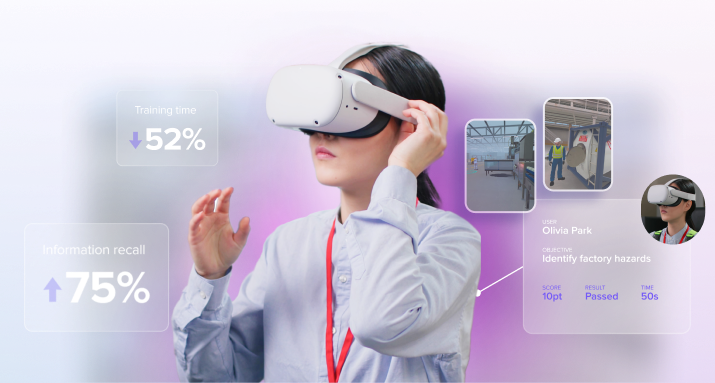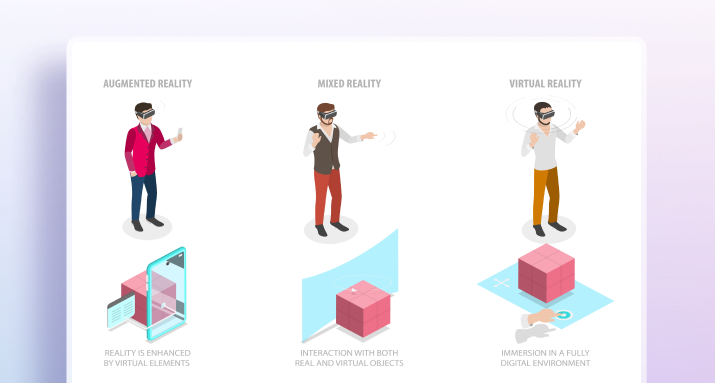
In this article
Predicting VR training ROI
Gaining stakeholder approval
Implementing a strategic roadmap for VR training success
In today’s rapidly evolving business landscape, organizations are constantly seeking innovative ways to enhance their training programs and maintain a competitive edge. Virtual Reality (VR) training has emerged as a powerful tool, offering immersive and effective learning experiences that boost operational efficiency and employee performance.
However, ensuring that VR training delivers measurable business value requires a strategic approach. Without a structured strategy, VR training initiatives risk unpredictable outcomes, inefficient use of resources, and costly trial-and-error processes that waste both time and money.
Over a decade of experience partnering with some of the most prominent enterprises has allowed us to identify a consistent formula for integrating VR training and realizing its full potential, driving impactful results and enhancing organizational performance. The Immerse ROI Calculator is designed to address this challenge by providing a proven methodology to predict the impact of VR training on your organization.
Immerse customers who followed this methodology have reported impressive results from VR training. Outcomes include a 52% improvement in speed to competence and an $8.59M increase in revenue by minimizing downtime. Customers have also experienced a 50% reduction in total training time, enabling quicker returns to work. Moreover, VR training has led to a 76% reduction in worksite accidents, enhancing workplace safety and cutting costs.

Gaining stakeholder approval for VR training is essential for the successful adoption and integration of this innovative technology into your organization. To secure buy-in from key decision-makers, it’s crucial to present a comprehensive business case that clearly outlines the expected ROI and strategic benefits.
Begin by highlighting the potential of VR training to enhance employee performance, reduce training costs, and improve workplace safety. Utilize data-driven insights and real-world success stories to illustrate the tangible benefits and efficiencies gained by other organizations. Provide a reliable forecast of the financial impact, ensuring stakeholders can make informed decisions based on projected outcomes. Demonstrating a clear, measurable pathway to achieving business objectives will help build confidence among stakeholders and secure the necessary support for your VR training initiatives.
Implementing a strategic roadmap for VR training success
Following this methodology, we´re helping organizations identify the best use cases based on specific goals, such as reducing costs, improving efficiency, or enhancing safety. By forecasting the impact of VR on your business and measuring success in financial terms and key performance indicators (KPIs), the ROI Calculator ensures accurate business impact assessments.
Implementing a Proof of Concept (PoC) using this methodology helps measure the business impact accurately. Once the PoC is successful, replicating this success across new use cases and regions maximizes the benefits of VR training.
Achieving predictable and scalable results becomes challenging without a tailored ROI forecast plan. Delivering predictable ROI helps organizations avoid these pitfalls and ensures they achieve measurable business outcomes. Integrating VR training into your organization with a reliable roadmap reduces risks, optimizes resources, and delivers predictable ROI.
Key metrics to measure ROI
VR training significantly enhances training efficiency by providing immersive, hands-on experiences. It improves knowledge retention rates due to its interactive nature, with studies showing higher information recall rates compared to traditional methods. By providing a safe environment to practice high-risk tasks, VR training can reduce workplace accidents and injuries.
Additionally, VR training leads to cost savings by reducing the need for physical training materials, travel, and downtime. Companies using VR training report that employees are better prepared and more efficient, mastering skills faster and performing tasks with higher accuracy, leading to increased productivity.
Strategies for measuring the ROI of VR training
ROI calculations consider various factors like training time, number of employees, and the type of training to provide an estimated return on investment. Data analytics and reporting features of VR training platforms track performance metrics such as completion rates, assessment scores, and error rates. This data helps in quantifying the impact of VR training on employee performance and overall business outcomes.
Implement pilot VR training programs to gather initial data and insights. This allows you to measure the effectiveness of the training on a small scale before a full rollout. Collect feedback from employees who undergo VR training to assess their learning experience and identify areas for improvement. VR forms can provide qualitative data that complements quantitative metrics.
By focusing on these key metrics and utilizing the right tools, organizations can effectively predict and demonstrate the ROI of VR training, ensuring that they maximize the benefits of immersive learning technologies.
Ready to unlock the full potential of VR training? Get in touch with our team to start planning your VR training project today.



